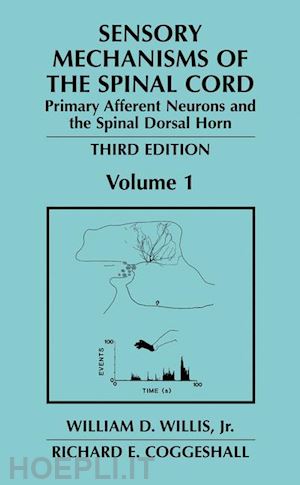1: Introduction.- Sensory Modalities and Channels.- Specificity versus Pattern Theories of Sensation.- Historical Perspective.- Specificity Theory.- Pattern Theory.- Gate Theory of Pain.- Supporting Evidence.- Molecular Basis of Specificity of Primary Afferent Neurons.- Sinclair’s Challenge and Evidence for Specificity from Microneurography.- Sensory Role of Single Tactile Afferents in Human Subjects.- Criticism of Microneurography Results.- Rebuttal of this Criticism.- Microneurography and Pain.- Somatosensory System Dualities.- Epicritic versus Protopathic Sensations.- Lemniscal versus Non-lemniscal Systems.- Large- versus Small-Fiber Systems.- Conclusions.- 2: Sensory Receptors and Peripheral Nerves.- Composition of Peripheral Nerves.- Sensory Receptors.- Cutaneous Receptors.- Cutaneous Mechanoreceptors.- Mechanoreceptors in the Glabrous Skin of the Primate Hand.- Cutaneous Displacement and Velocity Detectors.- SA I Receptors.- SA II Receptors.- Cutaneous Velocity Detectors.- FA I receptors.- Hair Follicle Receptors.- Field Receptors.- C Mechanoreceptors.- Cutaneous Transient Detectors.- FA II Receptors.- G1 Hair Follicle Receptors.- Sinus Hairs.- The Role of Growth Factors in the Regulation of Mechanoreceptors.- SA I (Merkel Cell) Endings.- FA I (Meissner Corpuscle) Receptors.- FA II (Pacinian Corpuscle) Receptors.- Hair Follicle Receptors.- Transduction in Mechanoreceptors.- Cutaneous Nociceptors.- A? Nociceptors.- C Nociceptors.- Transduction in Nociceptors.- Sensitization of Nociceptors.- Neurogenic Inflammation.- Peptidergic and Non-Peptidergic Nociceptors.- Nociceptors and Neurogenic Inflammation.- Interaction of Growth Factors with Nociceptors.- Inhibitory Interactions with Peripheral Cutaneous Nociceptor Endings.- Cutaneous Chemoreceptors Possibly Responsible for Itch.- Cutaneous Thermoreceptors.- Cold Receptors.- Warm Receptors.- Transduction in Thermoreceptors.- Muscle Receptors.- Stretch Receptors.- Muscle Spindles.- Golgi Tendon Organs.- Pressure-Pain Endings and Muscle Nociception.- Group III Muscle Afferents.- Group IV Muscle Afferents.- Sensitization of High Threshold Muscle Afferents.- Joint Receptors.- Joint Mechanoreceptors.- Slowly Adapting Joint Receptors.- Rapidly Adapting Joint Receptors.- Joint Nociceptors.- Sensitization of Joint Nociceptors.- Peptide Content of Fine Joint Afferents.- Joint Inflammation.- Role of Dorsal Root Reflexes in the Neurogenic Inflammation of Arthritis.- Visceral Receptors.- Visceral Mechanoreceptors.- Visceral Nociceptors.- Peptides in Visceral Afferents.- Growth Factors and Visceral Afferents.- Sensitization of Visceral Afferents.- Visceral Thermoreceptors.- Conclusions.- 3: Dorsal Root Ganglion Cells and their Processes.- Dorsal Root Ganglion Cell Bodies.- DRG Cell Classifications.- Cytologic and Size Classifications.- Myelination.- Axon Conduction Velocity.- Action Potentials and After Polarizations.- Classifications by Chemical Neuroanatomical Criteria.- Topographic Organization.- Innervation of Ganglion Cell Bodies, Pericellular Baskets.- Dorsal Root Ganglion Cell Processes.- Dermatomes.- Branching.- Ventral Root Afferent Fibers.- Spinal Cord.- Blind Fibers.- Looping Fibers.- Pial Fibers.- Function.- Segregation of Dorsal Root Fibers.- Conclusions.- 4: Chemical Anatomy of Dorsal Root Ganglion Cells.- Amines.- Catecholamines (CAs).- Histamine.- Serotonin.- Amino Acids.- Glutamate.- Aspartate.- GABA.- Glycine.- Channels.- Calcium Channels.- Sodium Channels.- Voltage-Gated Sodium Channels.- Cell Size.- Co-localizations.- ? Subunits.- Development.- Inflammation.- Peripheral Axotomy.- Nerve Growth Factor (NGF).- Peripheral Sensory Axons.- Non-voltage Gated Sodium Channels.- Enzymes.- Alkaline Phosphatase.- Carbonic Anhydrase (CA).- Cholinergic Enzymes.- ChAT.- ACHE.- Cytochrome Oxidase.- Fluoride-resistant Acid Phosphatase (FRAP).- Monoamine Oxidase.- Nitric Oxide (NO), Nitric Oxide Synthase (NOS) and NADPHd.- Ca++ Calmodulin Kinase II.- Other Kinases.- Hormones.- Corticotrophin Releasing Factor (CRF).- Insulin.- Peptides.- Angiotensin.- Atrial and Brain Natriuretic Peptide.- Bombesin.- Cholycystokinin (CCK).- Calcitonin Gene-related Peptide (CGRP).- Classification.- Age.- Development.- Co-localizations.- SP.- GAL.- SOM.- CCK.- VIP.- Bombesin, ENK, DYN, VIP, NT, and NPY.- FRAP.- Cysteine Proteases.- Amino Acids.- IB4.- Peripherin.- BDNF.- GDNF.- TrkA.- P75.- Experimental Manipulations or Disease.- Dorsal Rhizotomy.- Peripheral Nerve Lesions.- Inflammation.- Diabetes.- Hypoxia.- Hereditary Sensory Neuropathy.- Capsaicin.- Axonal Transport Blockers.- NGF Treatment.- Female Steroid Hormones.- Sympathectomy.- Dorsal Roots.- Periphery.- Somatic Innervation.- Visceral Innervation.- Endothelin (ET).- Galanin.- Nerve Lesions.- Inflammation.- Resiniferatoxin.- Axonal Transport Blockers.- Co-localizations.- CGRP.- SP.- VIP.- NPY.- 5-HT.- Glucocorticoid Receptors.- Dorsal Roots.- Neuropeptide FF (NPFF).- Neuropeptide Y (NPY), Polypeptide Y (PPY), and Peptide YY.- Peripheral Axotomy or Compression.- Trophic Factors.- Development.- Co-localizations.- Peripheral Innervation.- Neurotensin (NT).- Opioids.- Dynorphin (DYN).- Endomorphin.- Endorphin.- Enkephalin.- Nociceptin.- Oxytocin and Vasopressin.- Secretoneurin and the Chromagranins.- Somatostatin.- Co-localizations.- GDNF and Peripheral Axotomy.- Development.- Periphery.- Substance P (SP).- Segmental Levels.- Age and Development.- Co-localizations.- Tachykinins.- CGRP.- GAL.- SOM.- CCK.- ENKandDYN.- Bombesin, VIP, NT, and NPY.- FRAP.- NOS.- Glutamate.- IB-4.- 200 KD Neurofilament Protein.- Peripherin.- GDNF.- Opioid Receptors.- Experimental Manipulations.- Dorsal Rhizotomy.- Peripheral Nerve Lesions.- Inflammation.- Trophic Factors.- Adrenalectomy.- Resiniferatoxin.- Periphery.- Somatic Innervation.- Visceral Innervation.- VIP.- Proteins.- Calcium Binding Proteins.- Glutamate Transporters.- Reg-2.- Bone Matrix Proteins.- ?-arrestin.- Receptors.- Aminergic Receptors.- Adrenergic Receptors.- Dopamine Receptors.- Histamine Receptors.- 5-HT Receptors.- 5-HT1A Receptors.- 5-HT1B Receptors.- 5-HTlC Receptors.- 5-HT1D Receptors.- 5-HT1E Receptors.- 5-HT1F Receptors.- 5-HT2 Receptors.- 5-HT3 Receptors.- 5-HT4, 5-HT5, and 5-HT7 Receptors.- Amino Acid Receptors.- Glutamate Receptors.- Ionotropic Glutamate Receptors.- Metabotropic Glutamate Receptors.- GABA Receptors.- Glycine Receptors.- Cholinergic Receptors.- Nicotinic Receptors.- Muscarinic Receptors.- Hormone Receptors.- Androgen Receptors.- Estrogen Receptors.- Gender Differences.- Development.- Castration.- Glucocorticoid Receptors.- Insulin Receptors.- TRH Receptors.- Vitamin D Receptors.- Peptide Receptors.- Angiotensin Receptors.- Bombesin Receptors.- Bradykinin Receptors.- Cannabinoid Receptors.- CCK Receptors.- CGRP Receptors.- Endothelin (ET) Receptors.- Galanin Receptors (GALR).- Neuropeptide Y Receptors (Y-Rs).- Neurotensin Receptors (NT-R).- Neurokinin-1 Receptors (NKR1s).- NPFF Receptors.- Opioid Receptors.- MORs, DORs, and KORs.- Co-localizations.- Peripheral Axotomy.- Inflammation.- Development.- Periphery.- Endomorphin Receptors.- Endorphin Receptors.- Opioid-like Receptor 1 (ORL1).- Sigma Receptors.- Oxytocin and Vasopressin Receptors.- Somatostatin Receptors.- Vasoactive Intestinal Polypeptide (VIP) Receptors.- Purinergic Receptors or Purinoceptors.- Adenosine Receptors.- ATP (P) Receptors.- P2X Purinoceptors.- P2Y Purinoceptors.- Vanilloid Receptors (VRs).- Conclusions.- 5: Structure of the Dorsal Horn.- Lamina I.- Cell Types.- Classic Types: Marginal and Smaller Cells.- Modern Types.- Primary Afferent Input into Lamina I.- The Marginal Plexus.- Large versus Small Fibers.- A? versus C Fibers.- Propriospinal versus Primary Afferent Fibers.- Cutaneous, Muscular, and Visceral Afferent Input.- Neuropil Organization.- Lamina II (The Substantia Gelatinosa).- Cell Types.- Classic Cell Types.- Limiting (Limitrophe, Border) Cells.- Central Cells.- Funicular Cells.- Short-Axoned Cells.- The Gelatinosa as











